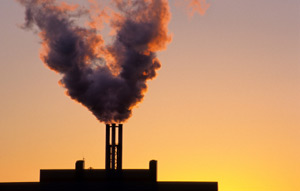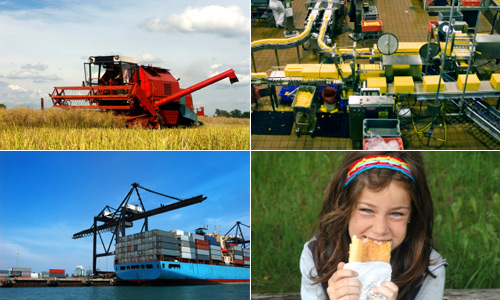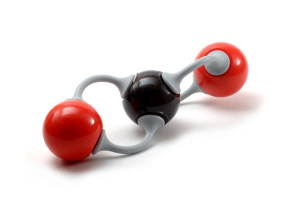
What are carbon emissions? ... Carbon dioxide and climate change

Every time we burn fossil fuels such as gas, coal or oil, carbon dioxide is released into the atmosphere. In a natural carbon cycle, carbon dioxide is re-absorbed by plants and trees. However, we are burning fuels where the carbon dioxide has been trapped under the earth's surface for millions of years, and we're doing it so quickly that plants and trees that are alive now have no chance of soaking it up (and it doesn't help that we're cutting down rainforests as well).
The effect of all this extra carbon dioxide in the atmosphere is that the overall temperature of the planet is increasing (global warming). Whilst the average global temperature is increasing, on a day-to-day level the climate is changing in unpredictable ways (from floods and hurricanes to heat waves and droughts). To try and reduce the risk of ever more extreme weather, we need to reduce how much fossil fuel we are burning. This isn't easy.
Using energy
We burn fossil fuels to create energy. From keeping warm in our house, to fuelling our cars, to growing our food, to manufacturing our MP3 players, energy is used. It is either burned directly (gas is burnt in your boiler for example, and petrol is burnt in your car) or it is burnt in a power station to drive turbines which generate electricity. Fossil fuels are also burnt at various stages in the process of creating food, products and services for our consumption. The total carbon which we as individuals are responsible for is called our carbon footprint.
Understanding your footprint

You may have seen carbon calculators on the internet that ask you about the food and products you buy (for example WWF's eco-footprint calculator) because of the effect of your purchasing habits on your carbon footprint. The more energy-intensive the process of creating the food and products you buy, and transporting them to your door (or local shop), the more fossil fuels are burnt (and therefore the more carbon dioxide is released). However, measuring these indirect emissions accurately on a day-to-day basis is very difficult.
Easier to measure are the direct emissions that we are responsible for. This includes the amount of gas and electricity we use in our houses, the amount of petrol or diesel we burn in our car, and the number and distance of flights we take. The Carbon Account is a tool to help you measure these direct emissions.
Getting the carbon dioxide figures right for gas, petrol and diesel is quite straightforward, because a standard amount is released when each fuel is burnt. Electricity is more complicated, but each supplier generates fuel in different ways (using coal produces the most carbon dioxide, whilst using renewable energy like wind produce no direct emissions).
The average carbon footprint in the UK is about ten tonnes. Of this, about half (five tonnes) is a result of indirect emissions (the carbon associated with food, products you buy, and your contribution to public services such as the NHS and police). The other five is a result of direct emissions (the ones the Carbon Account measures).
Clearing up confusion 
There is sometimes some confusion about the difference between carbon and carbon dioxide, and to understand the distinction, you'll need to remember your GCSE (or O-level) chemistry lessons. Carbon is the element that combines with oxygen to produce carbon dioxide. For every one molecule of carbon, there are two molecules of oxygen (hence CO2). Carbon on its own is not a greenhouse gas, but often CO2 is shortened to carbon for ease of reference, and this is the case with the Carbon Account.
As well as carbon dioxide, there are other gases (such as methane) which cause global warming. Collectively, there are known as 'greenhouse gases' and in chemical terms, most of them are hydrocarbons. For ease of comparing the warming effects of each gas, we can convert other greenhouse gases into carbon dioxide equivalents.
For more on the subject, there are lots of places you can go for further reading. A good place to start is the BBC's climate pages
The treasures of today
Yesterday of yesteryear is
The time that matters
Best right here

What does this saying mean?
Well, it means that, today will be tomorrow
And tomorrow will be of today as of every past year,
That should never to be taken for granted. This is the purpose
Of, (The Relevance of Time) It’s to be able to realize the
Importance of what really matters in one’s life,
Then begin to prioritize those matters.
With this said,
What one has in ones heart Y
Is more important than what one has in
Ones wallet ref; the gist of (The Human Heart).
After our time of life elapses, the treasures of money
Is worthless, whereas, our time of life by-passes,
The treasures of heart Y remain priceless
For the now and unending eternity.
Written and Designed by,
Don L. Johnson

